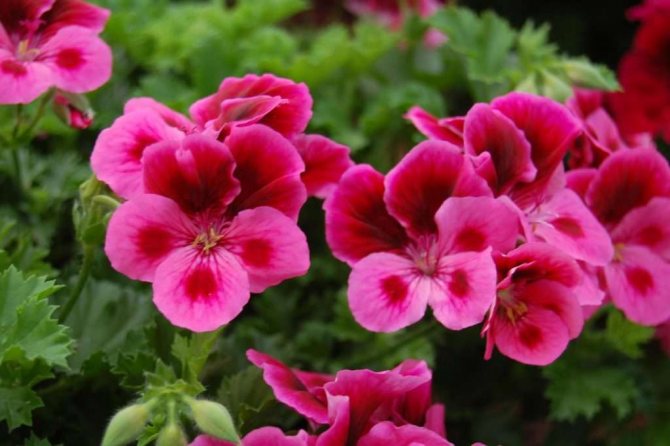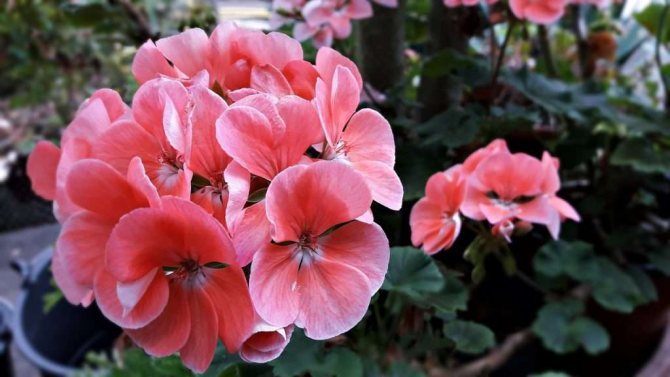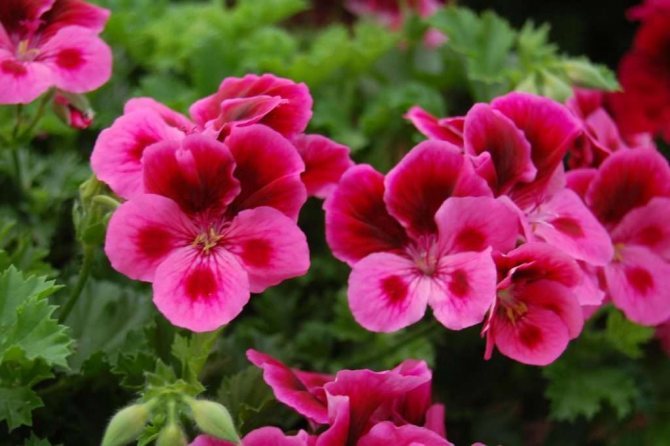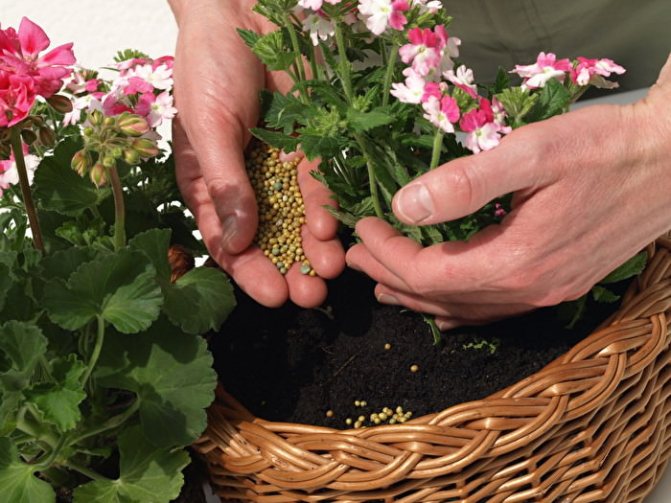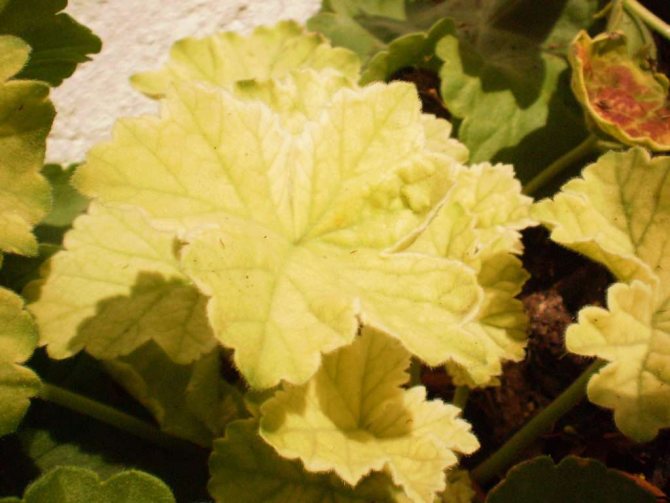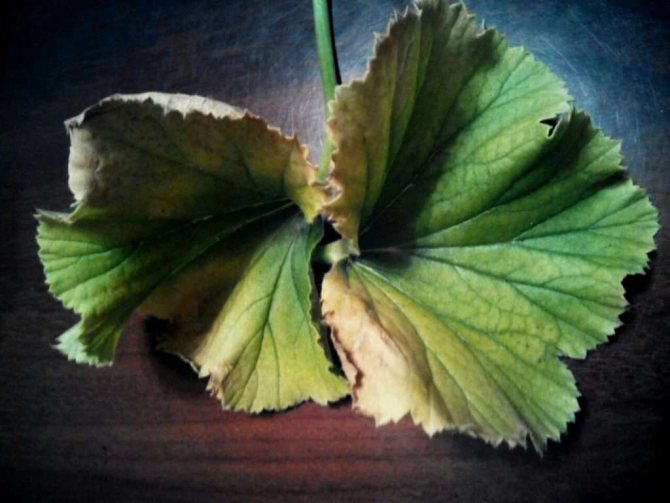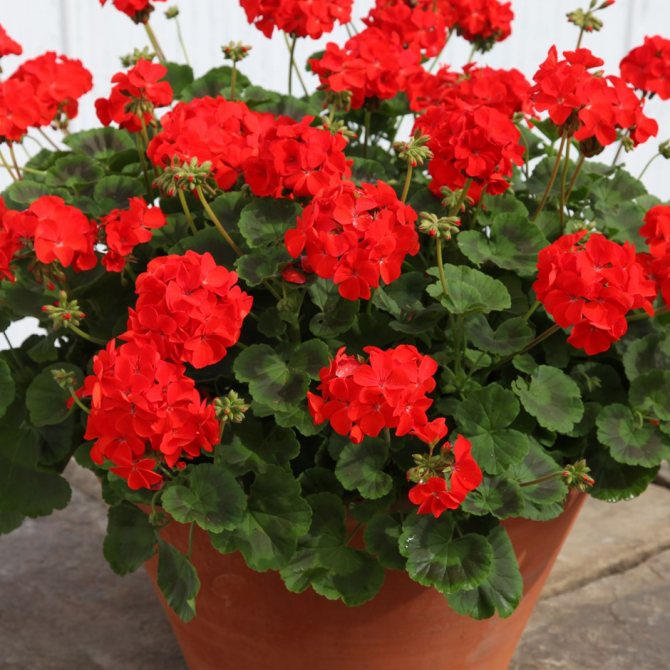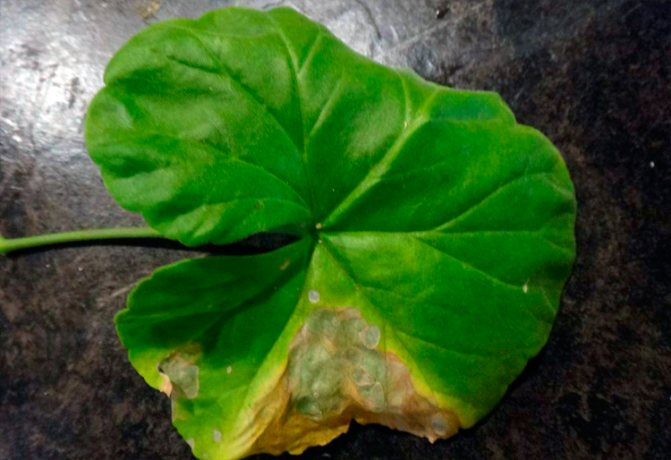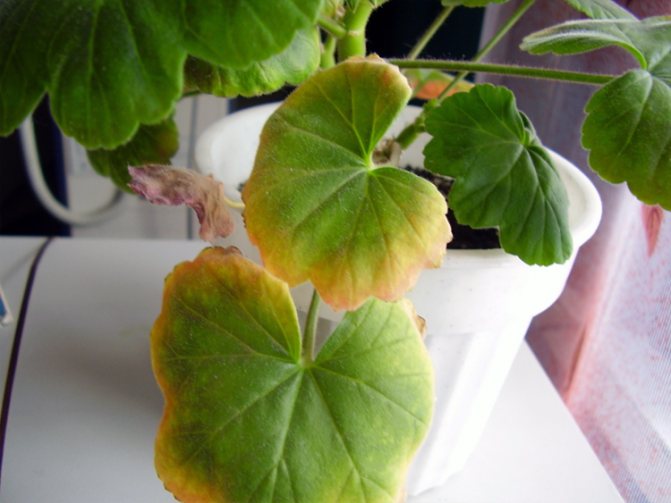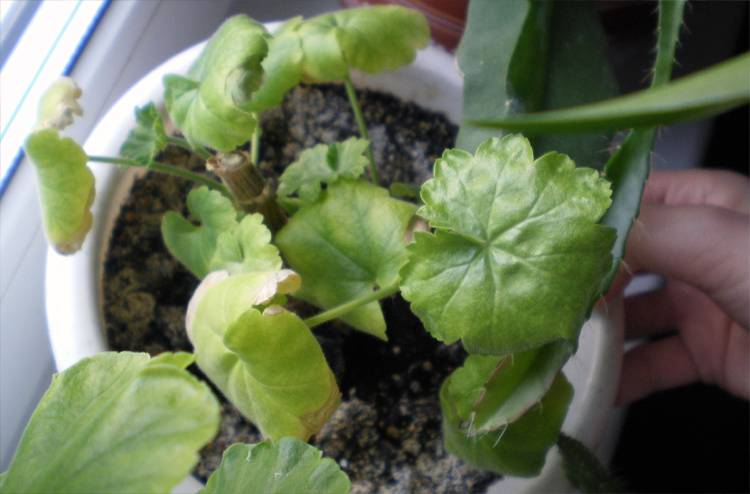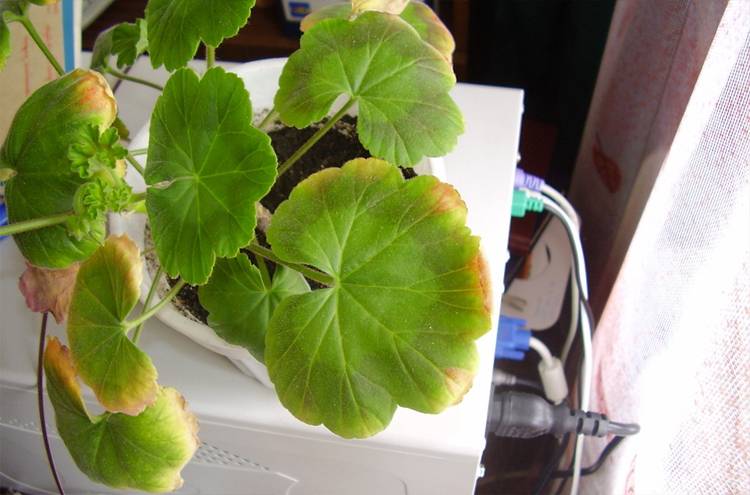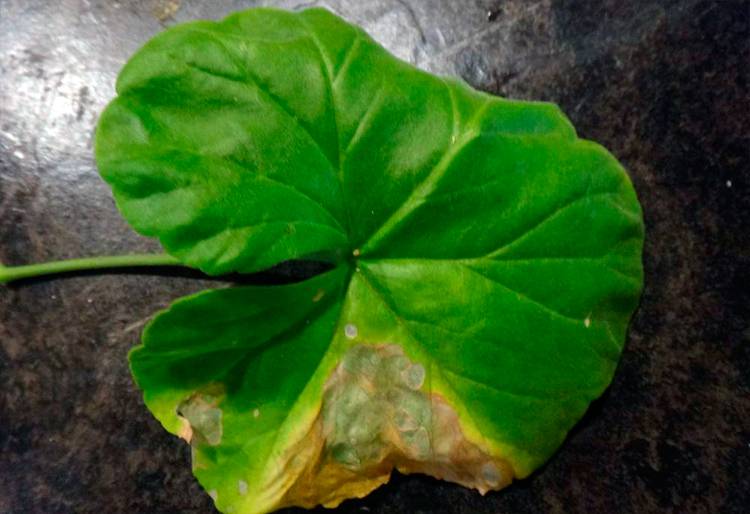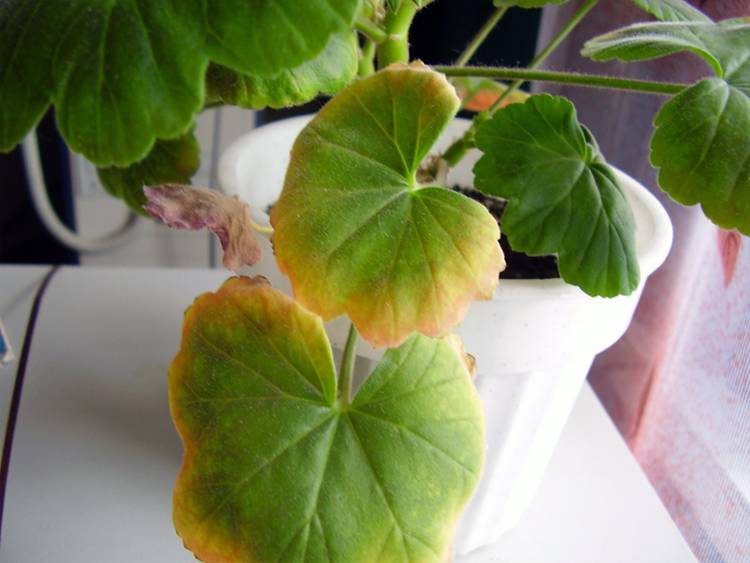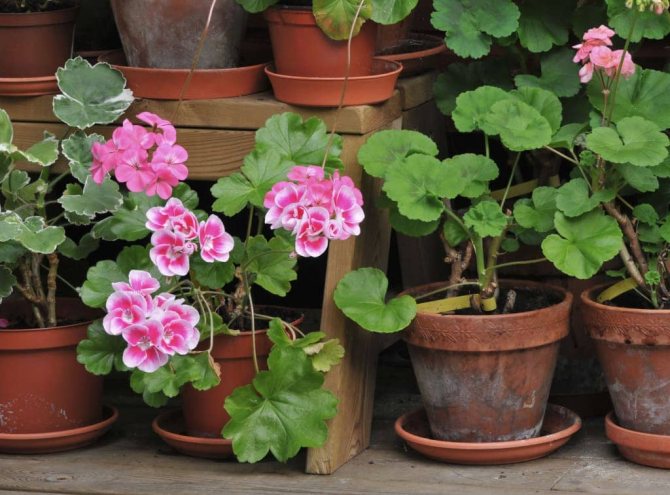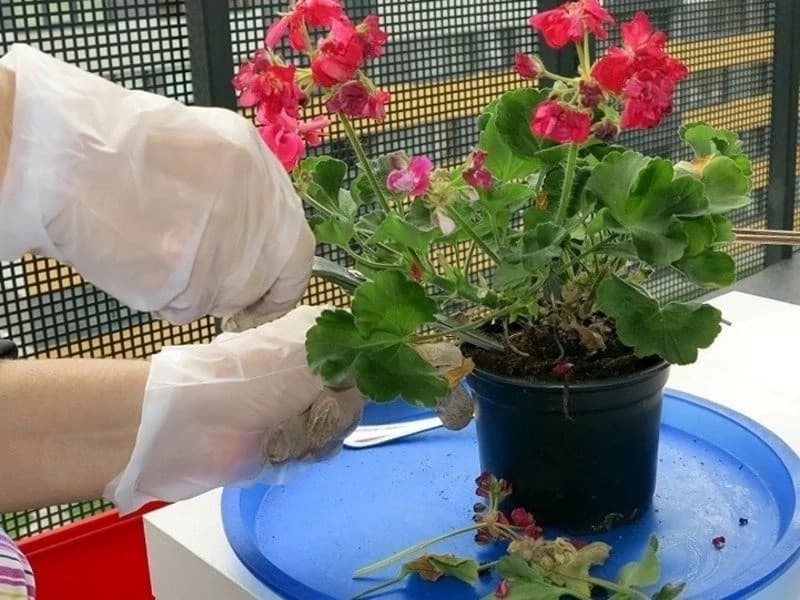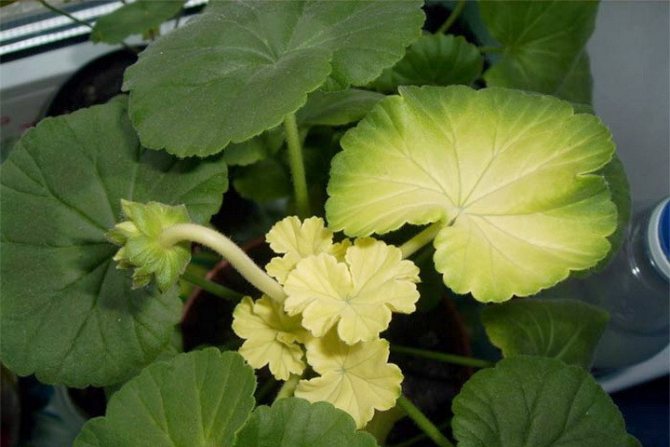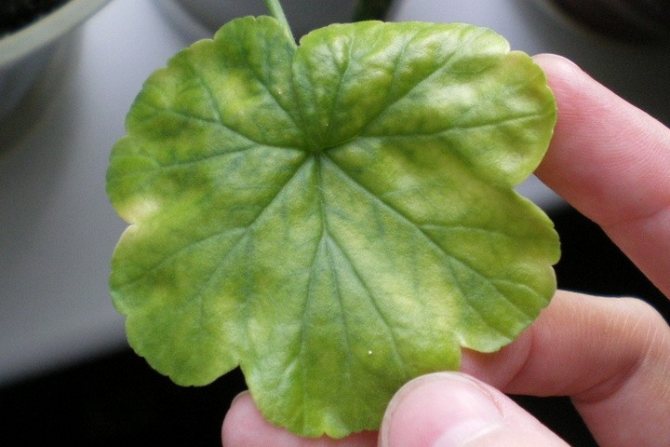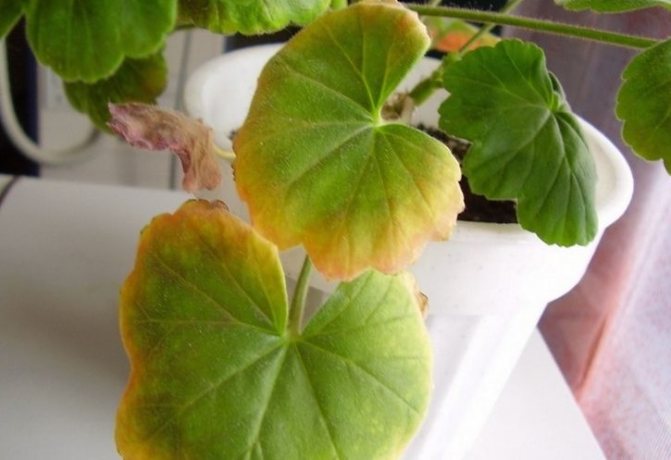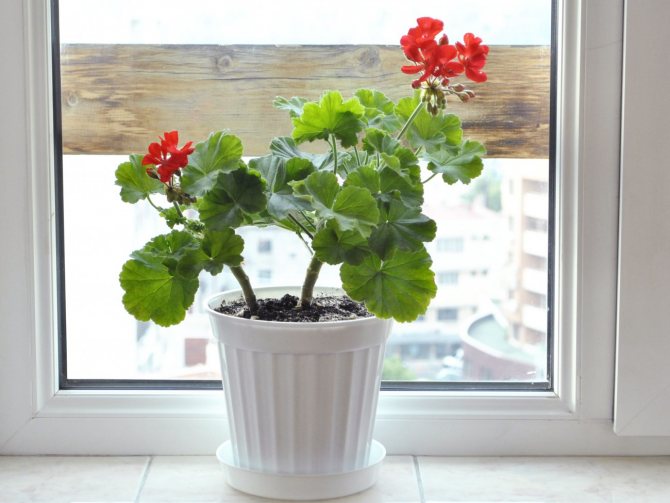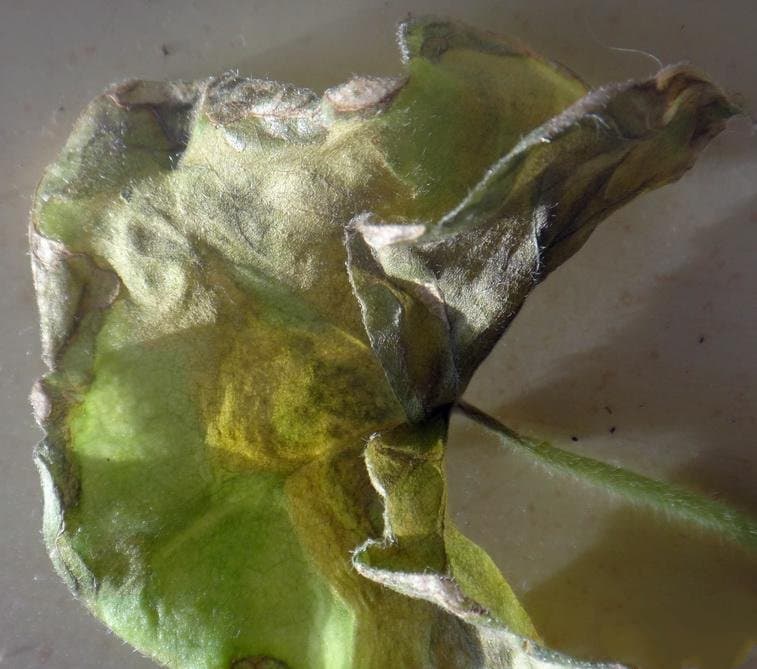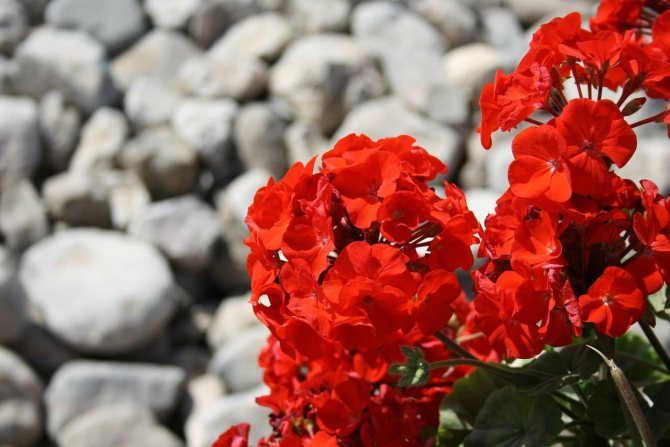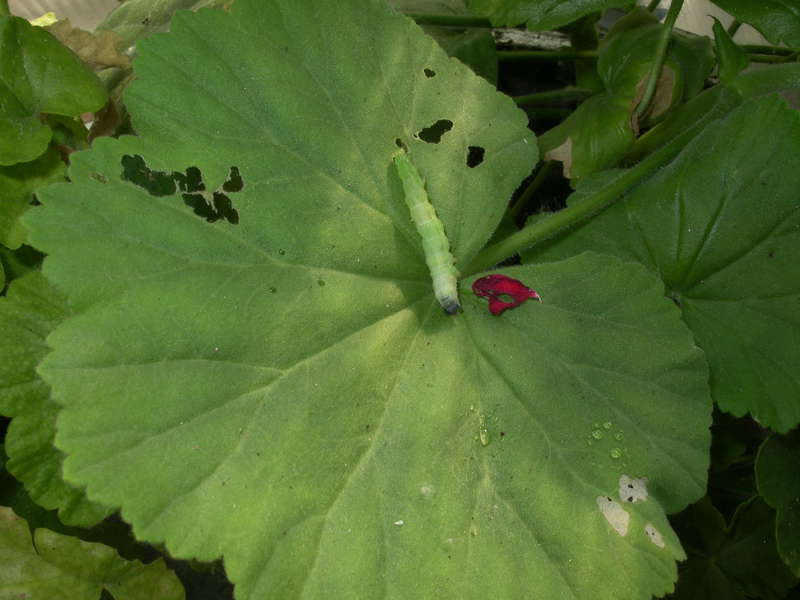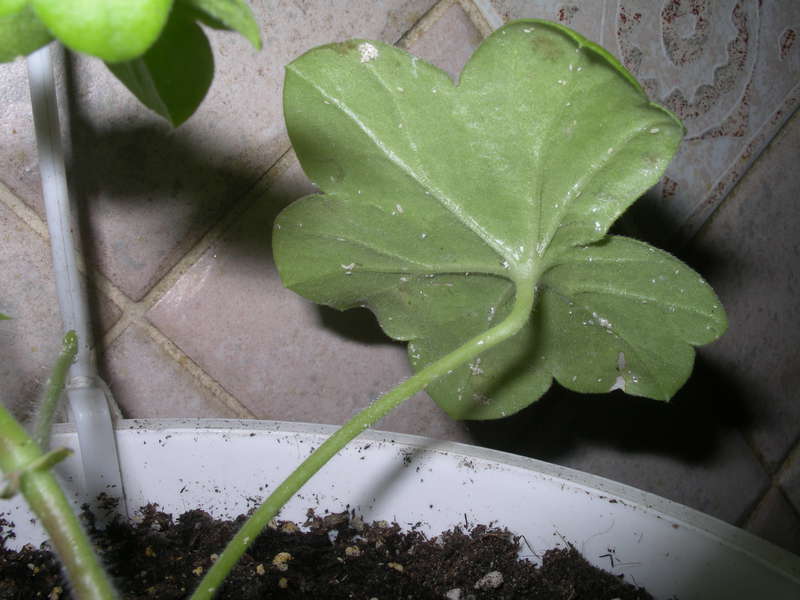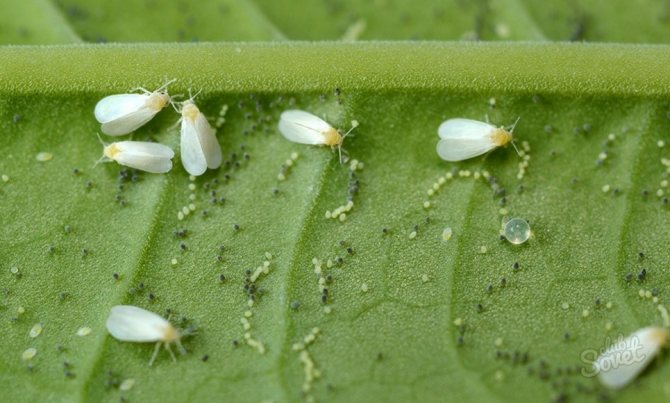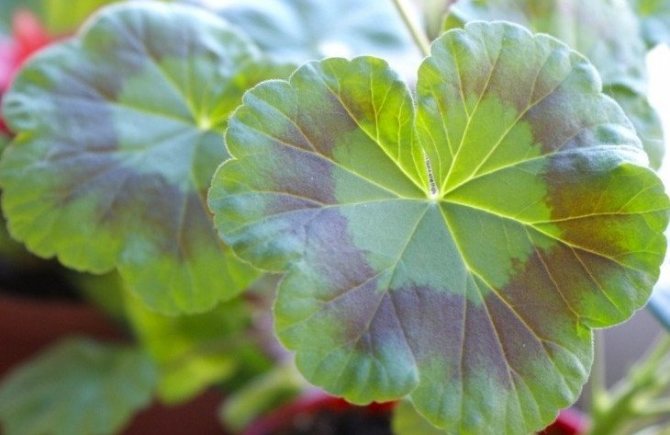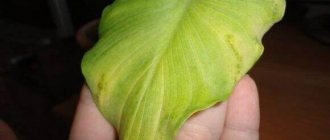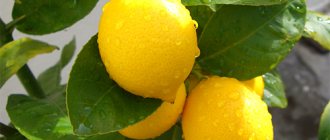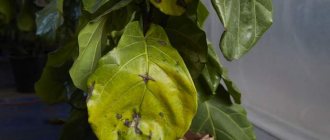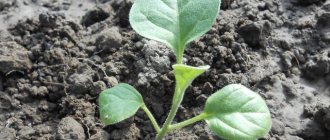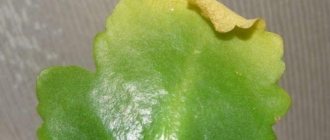Pelargonium, which we grow at home (mistakenly calling it geranium), is a beautiful and unpretentious indoor plant to grow. It fits perfectly into the landscape design of the garden area, as it feels good in the street. It is a wonderful home decoration, a bright reminder of summer. Sometimes the foliage of the "geranium" turns yellow at the edges. Gradually, the greenery dries, falls off, the appearance deteriorates badly.
If you do not take care of the flowers in a timely manner, they will die. For this reason, it is necessary to study the standard mistakes when growing "geranium", so that it always pleases with its appearance.
The main causes of yellowing
Yellow leaves spoil the appearance of the culture, but in addition, they can be a sign of a dangerous disease, pests. So if you do not take retaliatory measures in time, the plant may even die. So why do geranium leaves turn yellow? There may be several reasons.

Why does geranium turn yellow
A variety of varieties of geraniums are known today as a flower grower. Garden geranium pleases with a variety of species. Annuals and perennials, tall and miniature plants fell in love with landscape designers, gardeners appreciated their ability to "fit" into a flower bed or alpine hill.
An amazing flower, indoor geranium can accompany its owner, moving with family members to the dacha during the warm season, and returning to the apartment in the fall. At the site, the flower is transplanted into the ground, at home it feels good in a flower pot.
Geranium, like all plants, changes as it develops, the leaves can gradually dry out and fall off. But it happens that young leaves of the plant also begin to turn yellow, and such yellowing is a signal: geranium needs our support!
The reasons why geranium leaves turn yellow and dry are:
- Incorrectly created growing conditions;
- Diseases of the flower;
- Plant pests.
After getting acquainted with the rules of growing geraniums and caring for them, you will find the answer to the alarming question: "Geranium turns yellow, what to do."
It is interesting Useful properties of geranium
Prophylaxis


A few tips to prevent yellowing in foliage geraniums:
- It is important to keep the plant size and pot size consistent. As soon as the geranium pot "outgrows", it is recommended to replant the plant.
- It is also important to provide a suitable place for the plant with sufficient lighting (diffuse) and no drafts.
- Watering should be done regularly, but only if the top layer of the soil is dry.
- It is important to feed the decorative flower with appropriate fertilizers in time.
- In winter, keep the plant in a cool room.
- You should regularly inspect the flower for the detection of pests, the initial stage of diseases. And if there are alarming symptoms, take appropriate action immediately.
Common Leaving Causes of Geranium Leaves
Lack of proper care can lead to the fact that the plant will not bloom or even begin to wilt. It is not enough to plant geraniums in accordance with the instructions, if then certain rules are not followed.
Too infrequent or frequent watering
Spathiphyllum - leaves turn yellow: causes and treatment
Swampy soil is not the best option for the development of geraniums, but it also dislikes absolutely dry land. It is recommended to moisten the soil as the top layer of the soil dries up.
Important! In the fall, it is necessary to begin to reduce the number of watering, since in winter it is needed to a minimum.
Lack of drainage layer
Drainage prevents the formation of a bog in the flower pot. Home care for geraniums will be much easier if you add a layer of expanded clay or crushed stone to the bottom of the pot.
Cramped pot
Selecting a flower pot is required according to the size of the plant root system. Geranium begins to react to lack of space by yellowing foliage. This is due to the fact that in the soil there is not only insufficient nutrients, but also air for the flower.


Cramped Geranium Pot
Errors in care during the dormant period of the flower
In winter, the flower is required to be kept under certain conditions that differ from those that are necessary during the growing season. First of all, it is worth taking the flower to a cooler place, protecting it from drafts. It is not recommended to place the plant pot next to heating elements. Also, do not be zealous with watering. The amount of water and the frequency should be reduced, since less water is required during the rest period, especially in a cold environment.
Lack or excess of feeding
The amount of mineral components in the soil constantly dries up, and therefore from time to time they need to be replenished. Depending on the time of year and the life cycle of geraniums, fertilizers of different compositions are required. In the spring, nitrogen is needed to a greater extent, and in the summer - potassium and phosphorus.
Note! It is not always necessary to feed the plant if its leaves turn yellow. Perhaps this is a reaction to an excess of minerals in the soil.
Incorrect geranium placement
It is worth taking care of the correct placement of the flower pot in the house. Although geraniums love sunlight, you need to dim it a little. Fresh air is good for the plant, but because of this, you should not place the flower in a draft.
In winter, it is worth taking geraniums out to a cool room, but in this case, you should not leave them on the windowsill, since the sheets touching the glass can get frostbite. Being near heating appliances is also harmful.
High air humidity
Air humidity should be in the region of 50-60%. With a decrease and increase in this level, geranium begins to feel bad and signal this by yellowing its foliage. When the conditions are normalized, this reaction will disappear.
Transplant errors
Any flower undergoes transplant stress. After carrying out this procedure, it is worth observing the plant more closely.
Important! It is recommended to reduce the number of transplants to a minimum, to do it in extreme cases, since you can damage the geranium or choose the wrong substrate.
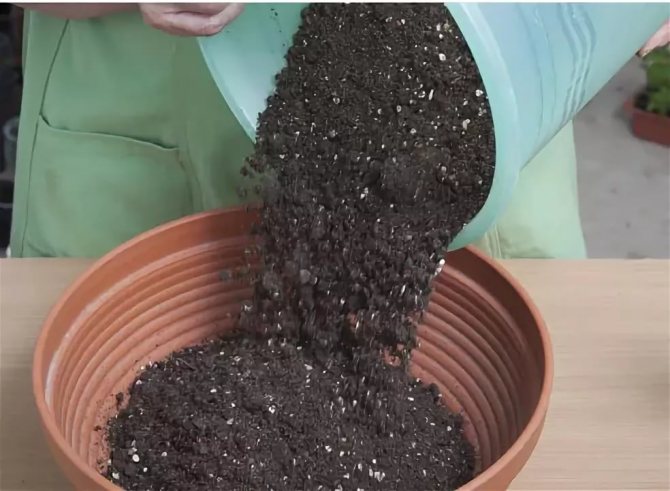

Substrate preparation
It is recommended to undertake the preparation of the soil. If this is not possible, it is worth purchasing a special substrate for ampelous plants. The soil should be moderately loose, slightly acidic or neutral acidity. It is worth making sure that there is a drainage layer in the pot. To prepare the substrate, you will need to take in equal amounts of humus, turf, peat and river sand.
Note! When transplanting, it is necessary to inspect the root system, carefully shaking off excess soil from it. It is recommended to cut off damaged roots with sharp scissors or a knife, and to process the cuts with charcoal.
The transplant procedure is required after a 2-hour break after abundant watering.
Errors in caring for geraniums
Check out these articles as well
- Spider mite
- Diseases of cabbage
- Zemklunika Merchant
- Fertilizer Kristalon
Most often, plants turn yellow due to poor quality care. The first step is to determine why geranium leaves turn yellow, and then decide what to do so that the flower can recover.
- High humidity indoors, where geraniums are located, is a common cause of yellow foliage. Most often this happens when the plant is irrigated from a spray bottle, right along the leaves. Geranium does not tolerate this procedure, so the leaves begin to fade first, then turn yellow and dry.
- Heat - a common reason why leaves turn yellow. The fact is that the best temperature for the culture in question is +20 degrees. Of course, in summer, when the temperature rises to +30 or more, the flower may suffer from heat. In room geraniums, this problem often arises, especially if there is no air conditioner in the room. In winter, this is also a common problem if the plant is near heating appliances.
- Lack or abundance of light... Geranium loves light, so it is always placed on a sunny window, where the light falls most of the day. If the plant is in the shade, the edges of the leaves will turn yellow, then they will completely dry out. At the same time, the direct rays of the sun can also provoke yellowing. From them, brown sunburns appear on the leaves. To solve this problem, it is worth choosing a place for the flower on the west or east window and, if necessary, sometimes darken it.
Interesting!
The leaves of a room geranium are capable of turning yellow if any chemicals get on them. These can be household detergents, substances for the treatment of plants (chemical), cosmetics.


If geranium is watered more often than 1 time a week, then it will turn yellow
- Excessive watering... Geranium is drought tolerant, but does not like the abundance of moisture in the pot. If geranium is watered more often than 1 time a week (1 time in 3 days during the heat), then it will turn yellow. In this case, the leaves turn yellow and dry chaotically. So if that's the case, you just need to adjust the watering. If there is not enough water for the flowers, the geranium will also turn yellow. So it is advisable to check how wet the ground is before carrying out the procedure. If it is dry 2.5 cm deep, then you can water the flower. The second option is mulching the earth with peat, moss, pine bark.
- No meals, the geranium will turn yellow. In this case, one transplant per year will not be enough, because the plant blooms annually, releases new leaves, pagons. So experts recommend fertilizing it with a complex mineral fertilizer for indoor flowering plants with a low nitrogen content. This fertilizer is applied at least once every 30 days.
- Drafts... If the flower stands on a window that is constantly open or in a place of draft, then yellowing and falling leaves will be the norm. The reason is that this flower does not like drafts. So there will be only one way to cure it - to find a place without a draft.
These are the most common causes of yellowing of geranium foliage, associated in one way or another with flower care. But, if the standards of care have been met, then the matter may be in something else.
Yellow leaves are a sign of geranium disease
Geraniums are provided with normal conditions, but her leaves still turn yellow and dry? A possible cause of this could be a plant disease.
Root rot
If the roots of a flower begin to rot, this affects its leaves. They will change their color from green to yellow, then the yellowness will acquire a brownish tint, and a whitish bloom may also appear.
It is best in this case to get rid of the diseased plant.But if the disease has just begun, you can try to help the flower. A diseased plant should be isolated from others to prevent the spread of the disease. The damaged parts are removed. Be sure to check the drainage of the soil, and so that excess moisture does not harm the roots, it is useful to add an artificial mineral - vermiculite or a special substrate component - perlite to the soil.
Gray rot
With gray rot, grayish spots appear on yellowing geranium leaves. Besides the leaf, they are formed on the stems of the flower. In this case, treating the plant with a fungicide such as Fundazol or similar preparations helps.
Rust
The yellowing of the upper part of the geranium leaf occurs when the plant is damaged by rust. Its characteristic feature is also brown spots on the yellowed part. The manifestation of this fungal disease requires a special attitude towards the diseased specimen. After removing and destroying the diseased parts, the flower is placed separately from the others. Colloidal sulfur belongs to the means used for rust, its use will help the plant.
Ring spot
Light yellow rounded spots on the leaf, resembling a ring in their shape, are a symptom of ring spot. An additional sign of the disease is further twisting of the diseased leaf, slowing down of plant growth, and cessation of flowering. To combat the disease, damaged leaves are removed, and geranium is treated with any fungicide.
Verticillosis
An unhealthy type of plant, in which its yellowness becomes more noticeable, the leaf turns yellow gradually, first in its lower part, and then completely - a sign of verticillary wilting. With this wilting, yellowness spreads from the leaves to the stems of the flower, and if you do not take action, the plant may die. Adding the fungicide to the soil will help the geranium and stop it from withering.
Phyto control measures
Disease is easier to prevent than to cure - this principle of prevention is also true for plants. And her main rule is hygiene. A plant clean from ailments and parasites and clean soil will be the key to the health of pelargonium. A flower can pick up an infection or a parasite anywhere: in a nursery, in a store, in the soil. To protect green pets, introduce home phytosanitary controls. These measures will ensure plant safety.
- Make sure the new plant is not infected with disease or parasites. Before bringing it home, inspect the stems and leaves, and if possible, the roots. If there are spots, dots, other damage or symptoms of disease, you need to be on your guard. Check geraniums for pests. An innocent white speck may be a mealybug. In case of severe damage, it is better to abandon the plant, it can infect others. And such an acquisition will bring more trouble than pleasure.
- The new plant, at first glance, is perfectly healthy. Do not rest easy on this and do not rush to put it to the rest of the green pets. Health problems may appear later. Fungal and viral diseases have an incubation period during which symptoms do not appear. And pests, the adults of which are destroyed, can leave the larvae. Keep the new flower isolated for at least two weeks, and preferably at least a month. Only after quarantine, introduce him to the rest of the neighbors on the windowsill.
- Be careful when replanting pelargonium. She doesn't like this procedure anyway. In addition, most bacteria, fungi and parasites spread through the soil. And store-bought soil is no exception. It may contain not only useful components, but also fungal spores. Before planting, be sure to disinfect the substrate and drainage by calcining, and pour boiling water over the pot. You can also water the new soil with a solution of some fungicide.


An infection or pest can enter the house from the greenhouse, so quarantine new plants
How is pelargonium useful, what medicinal properties does it have?
Pelargonium oil perfectly relieves muscle fatigue, back pain. Compresses pull pus out of wounds and help heal ulcers on the body. A few drops of oil relieve a runny nose, eliminate painful sensations inside the ear, headache. The delicate flower purifies the air around, its delicate aroma soothes the nervous system, relieves stress and relieves depression.
The medicinal properties of pelargonium can be compared to those of plantain. If you attach a leaf of it to the wound, it will stop the blood, remove pus and help it to tighten quickly. Geranium decoction is successfully used to treat diseases of the stomach, intestines, and helps with gastritis, diarrhea, colic.
The tincture helps with high blood pressure, sleep problems, neuroses. There are other beneficial properties of this plant that have a positive effect on human health. And so that it does not wither or dry out, you need good care and regular watering.
What are the types, varieties of pelargonium
Plants blooming at home include a large group of flowers, more than 15 sections of pelargonium, in other words, geraniums. Its species have several varieties that differ from each other, there are perennial and annual, evergreen, as well as varieties that shed their leaves depending on the season. Below are some types and varieties of indoor geranium with a photo.
The Otidia species has small leaves, thanks to which it can retain moisture and store nutrients. Undemanding in care, but loves warmth and light.
Hoarea has no stems, forms tubers, and a rosette with leaves emerges from the ground. Loves water and light. Blooms in winter. Pelargonium has flowers that give off a subtle and pleasant lemon scent.
Pelargonium is unpretentious in care, loves light, moderate watering.
- Odoratissimum has a lemon scent combined with rose and mint. No special care needed. The leaves can be put with other herbs in a bag and in a wardrobe.
Main varieties:
- Royal - has large beautiful flowers;
- Fragrant - exudes the smell of mint, lemon, pine, wormwood;
- Zonal - terry, star-shaped;
- Ampel - have leaves of an unusual shape.
Zonal and royal varieties are the most common, have a large number of varieties, in life they look the same as in the photo.
How to care for geraniums at home
At home, caring for room geraniums is simple, just a flower requires care and attention. For pelargonium, an abundance of air, sun and regular watering are important. The soil should be composed of sand, turf, humus and peat in equal proportions. It can be drained, loose, sour, neutral.
In the summer, the soil must be fertilized. Fertilizer should be saturated with nitrogen, phosphorus and potassium. The tops of the plant must be pruned periodically, then it will bloom and bush beautifully. Dry leaves must be removed immediately. The plant blooms from spring to late autumn, at this time it needs to be watered moderately.
Reasons why pelargonium leaves turn yellow
Many who have this flower at home often wonder why the leaves of the room geranium begin to turn yellow and fall off?
Leaves begin to change their color for the following reasons:
- abundant or rare watering - pelargonium does not like a lot of water, but the lack of moisture is also destructive for it;
- there is no drainage in the pot - the leaves turn yellow and there is no color;
- small pot - the roots cannot develop and grow normally;
- improper care in winter - the flower does not like drafts, strong moisture, high temperature (near the battery);
- a large amount of nitrogen in the soil.
Another reason why the leaves turn yellow is disease - verticillary wilting. First, their lower areas turn yellow, then they become completely yellow and fade, the yellowness passes to the stem.
To cure a flower, it is necessary to remove the damaged leaves and add a fungicide or trichodermine to the soil.
When asked why indoor geranium does not want to bloom, the answer is simple, the plant is sick, or the wrong care is taken for it. In this case, it is necessary to identify the cause and quickly eliminate it, otherwise it may disappear completely.
If pelargonium does not bloom in winter and its leaves are healthy, then the temperature in the room is elevated. As a result of an excessive amount of water, pads of a watery character may appear on geranium leaves. Due to the lack of light, they fall off.
If the stem turns black at the base, this is a "black leg" disease, in this case the flower must be destroyed, because the disease is contagious. The Botrytis fungus produces gray mold, the affected leaves should be removed, watering reduced, and the plant should be sprayed with a fungicide.
Pelargonium can be called a magic flower, it not only blooms beautifully and emits a pleasant aroma, but is also considered a miracle cure for many diseases. The useful and medicinal properties of room geranium have been known for a long time, it kills microbes, is considered a natural antiseptic, treats diseases of the stomach and intestines, neuroses, sleep disorders and much more.
If you properly take care of it at home, water it regularly, carry out disease prevention, it will always be beautiful, pleasing not only the eye, but also the soul.
Incorrect planting and transplanting of geraniums
After planting or transplanting plants, many growers observe yellowing of the leaves. The fact is that the procedure was most likely carried out incorrectly. Below are the common reasons why geranium leaves turn yellow after planting or transplanting.
- Unsuitable soil... For geraniums, loose, fertile soil is needed. If the soil is very heavy, clayey, if it lacks nutrients, then the flower may begin to dry. So it is best to purchase soil in a specialized store, specifically for this plant.
- Poor capacity... A spacious pot is selected for planting geraniums. If it is tight, the roots will grow quickly, the flower will slow down development, and then the leaves turn yellow and dry. Too large a pot can also hurt. In this case, the plant gives all its strength to build up roots, but flowering may not be observed at all. In this case, the leaves usually do not turn yellow, but young ones practically do not appear. In addition, water often stagnates in a large pot, which is harmful to the root system.


A spacious pot is selected for planting geraniums
- Drainage... The geranium pot should have a hole to drain off excess water and drain. If they are not there, the process of stagnation of water and rotting roots will begin. On the leaves, root rot is reflected in yellowing, starting from the lower tier.
Important!
If the reason for the yellowing of the leaves of a room geranium was an improper planting, transplant, the plant is simply transplanted into a new pot, a different soil. In this case, during this procedure, it is necessary to clean the roots from the ground and rinse them in a weak solution of potassium permanganate, just in case, for disinfection.
Errors during planting can be corrected only by transplanting into a new pot, soil.
Diseases that deform the plant
Improper care is not the only reason why pelargonium leaves quickly dry and turn yellow. The plant begins to deform and change its color under the influence of various diseases and even insects. The influence of any infectious disease or insect is individual. Today geranium can be overcome by the following pathologies:
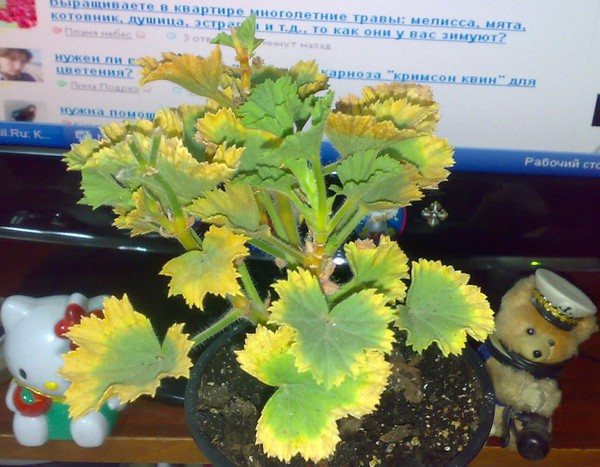

Rust. Rust is indicated by brown spots on the stems of the plant. Yellow spots appear after the dots. Over time, the leaves of pelargonium can completely fall off.- The formation of a yellow plaque according to the mosaic principle (the gradual merging of several yellowed sections of the leaf into one whole) indicates that a viral infection has overcome the plant.Such a disease cannot be cured. If geranium leaves turn yellow for this reason, the infected plant must be destroyed.
- Gray rot. The leaves not only turn yellow, but also become covered with gray rot. A velvet bloom appears on the edges of the leaf.
- Rhizoctonic rot. The stems, root and leaves are the targets of the gray fungus. The stems are covered with dark spots, and the leaves turn yellow.
- Bacteriosis Symptoms of the lesion are darkening of the veins on the leaves, dry yellow spots that can turn black inside.
- Alternaria. Geranium leaves are covered with yellow and brown spots. Brown plaque appears due to excess moisture.
- Verticillary wilting. A fungal disease that can destroy a plant. Yellowing of the lower leaves is one of the characteristic signs of the development of this pathology.
- Whitefly. The insect is small in size. It feeds on geranium juice. This insect addiction is detrimental to pelargonium. After contact with the whitefly, it withers and dries up. Both adult insects and larvae are dangerous.
- Spider mite. Like the whitefly, this parasite feeds on plant sap. Signs of a spider mite are the appearance of small dots on the leaves, as well as discoloration of some areas of the geranium.
- Aphid. The influence of aphids affects the external state of geranium leaves. They begin to curl inward and turn yellow.
Home care for round-leaved peperomia
Preventive measures
So that you do not have to take emergency measures to save your pet, you need to carry out regular prophylaxis.
Firstly, do not delay the plant transplant.
Secondly, observe the regimes of watering and feeding.
Thirdly, let the flower "rest" in the cold season.
Fourth, carry out regular inspections for the appearance of pests and diseases.
Fifth, do not create extreme conditions for your pet.
At sixth, don't forget about drainage!
Seventh, never spray geraniums and wipe the leaves with a damp cloth!
Pelargonium leaves turn yellow and dry: preventive measures
It is much easier to prevent yellowing of the leaves than to cure an already diseased plant. In order not to have to fight to save your beloved geranium, you should:
- Transplant pelargonium in a suitable pot in time.
- Find a place for her, closed from drafts, with a sufficient amount of diffused light.
- Water as the earthen coma dries.
- Apply mineral complex fertilizers on time, suitable for flowering plants. The rates and schedule of application are indicated in the instructions for the tool. During the flowering period, it is recommended to do root dressing twice a month. Organic fertilizers will also be helpful.
- In winter, you need to try to keep the geranium cool.
- Regularly inspect the plant for infestation by pests, bacteria, fungi and viruses, providing treatment if necessary.
Yellowing of geranium leaves is an alarming sign. It is important to understand in time the cause of such plant malaise. Having carefully examined it and analyzed the conditions of keeping pelargonium, you can find what provoked such a reaction. The sooner the mistakes are corrected, the less damage the geranium will do.
Growing features
It is not difficult to take care of this plant - even an inexperienced grower can grow geraniums. Note, however, that the flower requires, though not too zealous, however, regular attention.
How to care for geraniums at home? The following points are important conditions for the successful development and growth of geraniums:
- a lot of air, free space;
- sufficient sunlight;
- abundant and regular watering.
A suitable substrate should be composed of the following components, taken in equal proportions:
- river coarse sand;
- sod land;
- peat substrate;
- humus.
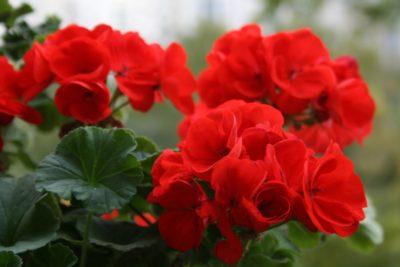

It is also desirable that the soil is well-drained, moderately loose, neutral or slightly acidic. An alkaline substrate is not suitable for geraniums. The plant needs feeding, as this is very important for caring for geraniums at home. How to feed and water so that the plant does not get sick? The following trace elements are especially important for geranium:
- phosphorus for flowering;
- potassium for growth;
- nitrogen for abundant and lush green mass.
In addition, regular pruning is also important for geraniums. This procedure will allow the plant to bloom beautifully and form a lush compact bush throughout the growing season. Dry foliage must be removed immediately so that it does not draw on the nutrients intended for fresh greenery and flowers.
How to save a dried plant?
The appearance of dry leaves is not a sentence. The plant can always be saved, especially if you start doing it as soon as possible.
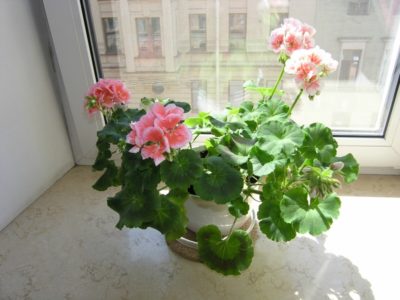

It is necessary to analyze whether all conditions have been created for the comfortable existence of geranium and whether she has enough light and air, she is not poured too much and no more fertilizers than required.
It is necessary to protect the flower from direct sunlight and drafts, monitor the air temperature and soil moisture, do not feed it in the autumn-winter period, prune it in a timely manner and regularly examine it for signs of diseases or pests.
In most cases, the problem of drying leaves is solvable. The main thing is to detect it in time and immediately begin to eliminate the causes.
Geranium pests
Another reason why geranium leaves turn yellow is pests. They can appear on room geraniums, even if earlier, such insects did not infect crops, since the eggs and larvae of pests often live in the ground. If the ground before planting was not calcined or Treated with potassium permanganate, the appearance of pests is not excluded.
Most often, a whitefly can be found on a flower. She lays eggs under the leaves and when the pest colony grows, the edges of the leaves begin to turn yellow, then turn brown and dry. It is not difficult to see the whitefly, it is about 3 mm in size, the wings are white.
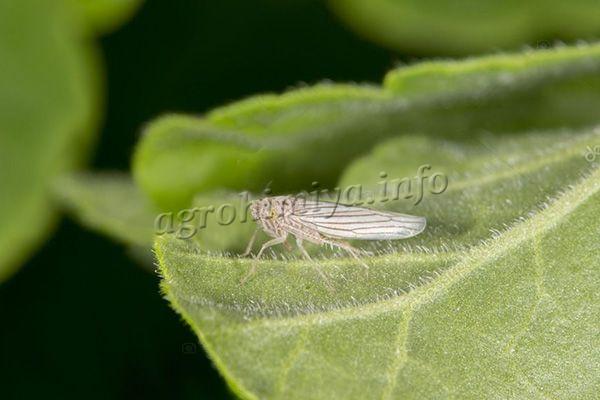

Another reason why geranium leaves turn yellow - pests
Important!
Pests rarely affect geraniums due to the fact that the flower has a very strong, frightening smell.
If the leaves turn yellow and curl inward, then this is a sign of aphids on the geranium. This parasite is small, it is not easy to notice it, but it brings a lot of harm. If there are ants in the house, then sooner or later aphids will appear on the flowers, since these insects have a special symbiosis.
What to do if pests appear? For the destruction of pests, you can use insecticides "Fitoverm" or "Mospilan". They do well with insects on geraniums, but it is better to process them not indoors, but on the street or on the balcony.
Diagnosis of the disease: why does the flower dry up?
Some do not attach much importance to such an alarming symptom as wilting and discoloration of the leaves. And this is wrong. Dried foliage is a warning sign of deteriorating indoor plant health... A careless attitude to this problem leads to the loss of decorativeness, blackening of the trunk and even to the death of geraniums.
That is why at the first sign of drying out of the leaves, you should identify the cause and do everything possible to help the plant regain its original beauty.
Read more about the most common causes of geranium ailments here, and from this article you will learn about plant leaf diseases.
Leaves are affected from the edge in a circle


To correctly diagnose and accurately determine why the foliage is drying up, you should carefully examine the bushes. So, if the leaves dry in a circle, then this happens for three reasons:
- Lack of moisture... Irregular or poor watering leads to the appearance of a dry yellowish-brown border on the leaves, easily visible to the naked eye.
- Unsuitable temperature conditions... The optimum temperature for geranium growth is +20 degrees. If this indicator changes sharply upward or downward, then the leaves will dry out and fall off. It is noteworthy that the dry border first has a reddish tint, and then becomes light yellow (why do geranium leaves turn red?).
- Cramped pot... The small house also causes the leaves to dry out. The loss of a healthy color begins gradually - the edges turn yellow first, and then the process spreads over the entire area of the leaf plate.
In fact, not everything is as bad as it might seem at first glance. Dry leaves are easy to treat. The main thing is to accurately determine the cause and choose the right measures to combat this unpleasant phenomenon.
Partial and complete dieback of leaves
The question of why leaves dry up has several answers. Here are situations when the natural beauty of geraniums is disturbed by partially or completely dried leaves.
- Large, or vice versa, insufficient amount of light... The plant does not tolerate both direct exposure to sunlight and lack of lighting. In both the first and second cases, the leaves begin to dry out and turn yellow, the stem is strongly stretched, and flowering stops.
- Stagnant water... Excessive watering, as well as a lack of life-giving moisture, leads to unhealthy bush. The leaves become watery and lethargic, the root rots, which subsequently leads to the drying of the crown.
- Excess or deficiency of fertilizers... When applying dressings, you must follow the instructions. Otherwise, the leaves may turn yellow too.
- Unsuitable soil... Geraniums require light and fertile soil to grow effectively. On heavy and poor soils, the fragrant beauty develops poorly.
- Adaptation period... If you change the environmental conditions of the plant (transplanted into a new pot, moved from the windowsill to the street), then the leaves also sometimes turn yellow. After the end of the adaptation period, the previous color is restored.
- Drafts... Another common cause of leaf drying. You need to eliminate it, and everything will work out by itself.
- Diseases... Some diseases, such as gray mold, Alternaria and rust, cause leaf drying. In this case, other signs of damage appear on the crown - brown spots, velvety bloom, brownish dots.
- Pests... If it is noticed that the leaves of the geranium have dried up and turned yellow, then you need to examine the plant in order to identify parasites - whitefly or aphids.
Withering and dying off of buds
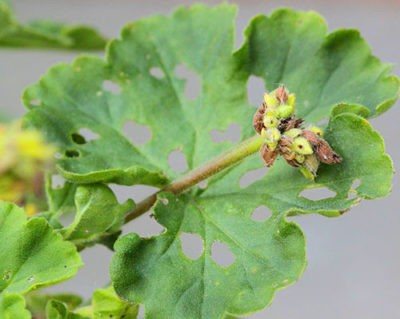

Geranium buds dry out for the same reasons as leaves. But the most common are three.
- Micronutrient deficiencies, in particular phosphorus... When purchasing specialized fertilizers, you must ensure that they contain phosphorus.
Lack of phosphorus can be compensated for with boric acid (1 g) diluted in a liter of water. - Little light... For the full formation of buds, light is needed. If it is not enough, then flowering will be poor - half of the buds will dry out.
The solution to this problem is simple - it is enough to organize the lighting and everything will immediately fall into place. - Heat... If the thermometer rises to an abnormally high mark, then the buds will not stand it and, most likely, will dry out.
Attention! Sometimes the drying of the buds lies in the specific features of the geranium. Some varieties, for example rosebud geranium, bloom in the third year, in the first 2 years the buds are formed, but dry up.
In addition, the buds dry out with improper watering, abrupt changes in environmental conditions and diseases.
The appearance of insects, how to deal with them
One of the reasons that leads to yellowing, wilting, drying out is the spread of insect pests.
Ticks.Mites arise as a response to excessive dry air. In addition to changing the shade of parts of the plant, they cause changes in the structure of the stems. The plant is treated with soap solutions, ticks are removed using soft bristled brushes.
Mushroom mosquitoes. These parasites infect the stems first, after which the unpleasant symptoms spread to the leaves. They start to turn yellow. In the absence of timely measures to combat insects, the flower dies.
Thrips. The appearance of these parasites can be detected with the following symptoms:
- yellowing;
- bloating, bumpiness from below;
- damage to the flower.
Thrips destroy buds. Measures to combat parasites are called weekly treatments; special solutions are made for them with the addition of copper-containing elements.
Aphid. Varieties are considered aphid resistant, but infestation occurs on rare occasions. This is facilitated by the neighborhood with vegetable seedlings on the windowsill or in the conditions of glazed loggias or balconies. The appearance of aphids is accompanied by yellowing and curling. It is recommended to remove the affected areas, treat the remaining parts with soapy water.
Caterpillars. The appearance of caterpillars is characterized by various symptoms, from yellowing to blackening. Tracks can only be detected with a thorough visual inspection. They are destroyed with bactericidal insecticides. For processing, solutions are used with minimal doses of concentrate so as not to harm the plant. After processing, the plant is not watered abundantly, it is left to rest for a day.
How to avoid problems
So that the flower grows fully and pleases with its appearance, you need to initially take care of its correct development... It is important to choose the correct size of the pot, for geraniums it should not be too large or small. The approximate diameter is up to 15 cm. A drainage layer must be placed in the pot. Otherwise, the roots of the plant will remain in water for a long time, and this can lead to the death of the flower.
The plant can get sick from watering with hard tap water. Therefore, the water must be defended, such water will become softer and will not harm the flower.
It is important to ensure that there are no sudden temperature changes in the habitat of pelargonium. There is no place for a flower near a ventilated window or under an air conditioner.
You also need to promptly remove wilting flowers. You do not need to tear them off roughly, it is better to carefully cut them.
Besides the fact that geranium is very beautiful in itself, it is also an excellent natural antiseptic... It reduces the growth of bacteria in the room. And we can talk endlessly about its healing and cosmetic properties. For example, a geranium leaf applied to the bridge of the nose will cure a cold. Pelargonium essential oil will help get rid of acne.
Lack of light
Signs.
Gradually, the lower leaves turn yellow and dry, the stem stretches, geraniums very rarely and bloom little.
Decision.
Change the place of residence of your young lady. Put it closer to the light or even hang additional lighting with phytolamps. Do not touch the leaves themselves. You can pinch the top of your head so the geranium grows wide. Otherwise, only a bare stem and a bunch of leaves on the crown will remain.
If you already have such a "miracle", then the best option would be cutting cuttings and rooting. Because new leaves will no longer grow on the stem.
how to make hippeastrum bloom
Water scarcity
Signs.
The leaves of geranium have a dry yellow border of a dark, almost brown hue. The pigmentation is visible throughout the plant.
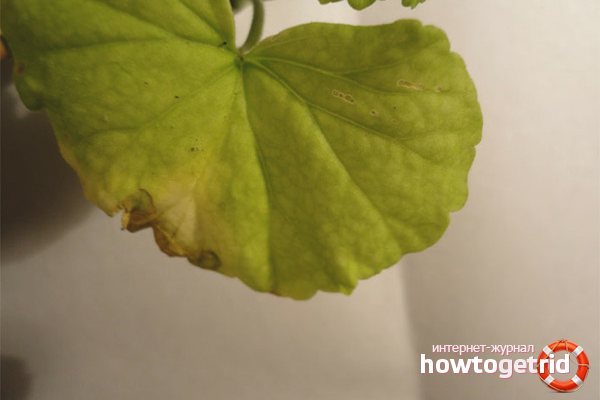

Decision.
Watering is described above. You should not rush from one extreme to another and completely dry out the earthen lump. Geranium is also a living plant, loves to eat and drink. Especially in summer and hot weather.
Don't have time to water the flower often? Place him in safer hands. Or change geraniums where the temperature is lower.This will allow the moisture from the pot to evaporate more slowly, and the roots will not suck it in at the speed of the pump.
By the way, if there is a possibility, then in the summer you can not torment the beauty with a hot window sill, but transplant her directly into the open ground. Not in direct sunlight. Preferably where you most often run with a watering can or a watering hose. In the fall, you will not recognize your geranium. Instead of a stunted stick with yellowing drying leaves, a beautiful powerful bush with juicy green burdocks will grow.
Just do not plant it in the far corner of the garden or plot. You will definitely forget.
how to transplant a flower into another pot
Pot too small
- As a rule, too large a pot is not needed for geraniums. When the geranium grows, its leaves turn yellow because there is too little space for it. If you transplant the plant into a larger pot, the problem will be eliminated.
- Planting tanks for pelargonium should have a drainage hole and good drainage, because "wet feet" generally do not like sun worshipers.
- Geranium is ideal for pots or large window frames (20 x 100 centimeters). You can place about five plants in them. For good fertilization and water supply, the box should be at least 18 centimeters.
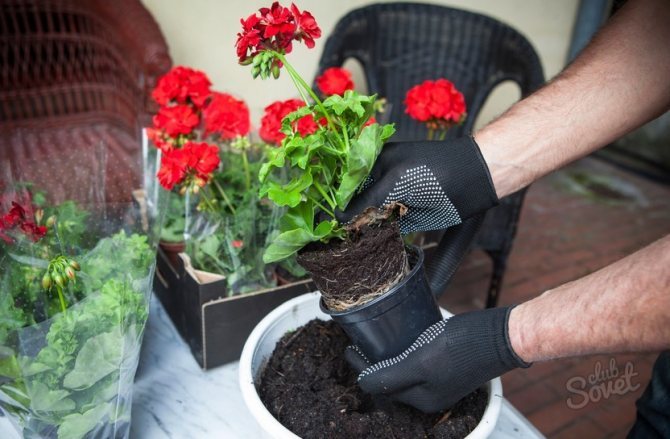

Excess moisture
Signs.
The leaves turn yellow at the tops of the shoots, then become lethargic, watery. The last stage is stem decay and leaf drying.
Decision.
Stop creating a swamp in your geranium pot. Check drain holes for clogged debris and overgrown roots. If this problem is relevant, then carefully remove the holes. Better yet, transplant the plant into another pot.
Water your pet correctly. Since geraniums are often placed on a sunny window, the topsoil dries out quickly enough, forming a crust. But it’s still humid enough downstairs. Many are too lazy to dig in the ground before the next watering and see what happens below the level of the crust. And the geranium is watered again.
Get in the habit of sticking a wooden skewer or sushi stick all the way to the bottom of the pot for 12-14 minutes. Then take it out and watch. On unpainted wood, the level of moisture in the ground will be clearly visible.
And further. Geraniums do not have a strictly regular drinking schedule. Water is given to the plant only when the soil in the pot is almost completely dry.
why do the leaves of orchids turn yellow
Excessive irrigation
- Irrigation is very important for the cultivated plants. We often think that the more water we give them, the better it will be. But the reality is not always like that. Whether we water a little or a lot, geraniums will have problems. If over-watered, the lower leaves will begin to turn yellow and eventually fall off. The plant will look sad.
- What to do? It is most advisable to remove the plant from the pot, wrap the root ball in absorbent paper and leave it out of direct sunlight until the soil is completely dry. Then, transfer it to a container and spray it with a fungicide to prevent fungus growth.
- In winter, geraniums are kept fairly dry and are watered only occasionally.


Lighting and temperature control
- Pelargonium comes from South Africa. It is suitable for a hot climate, where the temperature is stable, approximately 20-30 ° C. Cold is a mortal enemy for these plants. The temperature should not be lower than 10 ° C, and the frost kills them quickly. In indoor conditions, the plant feels good.
- Geraniums should be grown in very bright areas or in direct sunlight. It is recommended to expose geraniums to 4-6 hours of sunbathing. If they are grown in greenhouses, they must have intense lighting to promote the appearance of flowers. Light is a very important factor in the flowering of these plants.


Provide the right conditions for the geranium and it will not have problems with leaves. And her flowers will delight you!
Sunburn


Geranium is excellent for direct sunlight and can be outdoors in the summer under the sun's rays. But the hit of such rays on the flower through the window glass leaves sunburn on the sheet plates. First, those leaves that are closest to the glass, and sometimes even pressed against it, suffer. Spots of a yellow-brown hue appear on them. Such yellowing does not pose a threat to the life of geraniums, but the decorative qualities still suffer. After replacing the growing site and pruning damaged shoots, the beauty of geraniums is gradually restored.
2) Lack of irrigation
- Geraniums need frequent watering in summer. During which it is recommended to water about three times a week. But when we water less than necessary, the leaves turn yellow and look sad. In addition, they can be curled from all edges at the same time.
- What to do? Water, of course. Take a pot and place it in a bowl of water. The earth must be well saturated. Thus, geraniums can recover quickly.


Subcontract poorly nourishing plant
- Pelargonium needs a loose and fertilized soil. It must be transplanted into a new substrate every two years, otherwise, the roots will run out of nutrient and the plant will begin to weaken. If the leaves on plants (not only geraniums) gradually turn yellow, this is often a signal of nutritional deficiencies, especially if the leaf veins themselves remain green.
- What to do? In addition to replanting it every two years, it is very important to feed the plant from spring to autumn with fertilizer for flowering plants, following the directions on the package.
- Yellow leaves on geraniums often indicate a deficiency in the trace element iron.
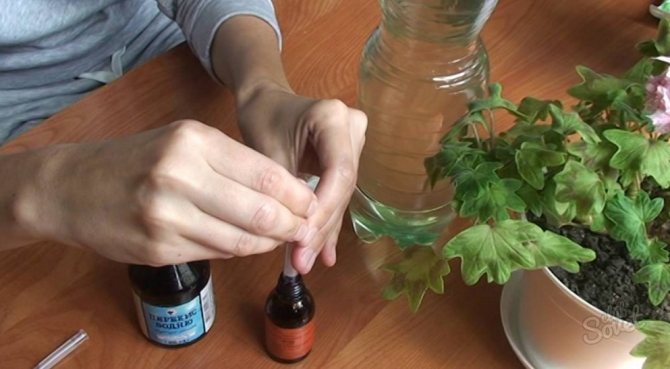

Reproduction of room pelargonium
Home geranium, i.e. pelargonium, propagated by seeds and vegetatively.
Cuttings
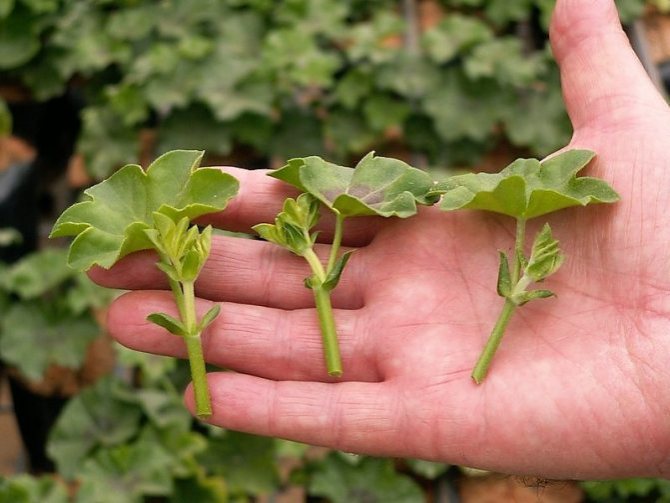

This is the easiest and fastest way - with cuttings. In addition, the characteristics of the mother plant are fully preserved, and the first flowering already occurs in the first summer after rooting. Cut the cuttings from the tops of an adult plant, 7-10 cm long, with four to five leaves. Make a cut obliquely under the kidney. Tear off the bottom pair of leaves. Let the cuttings lie in the air for two to three hours so that the slices dry out and, as it were, tightened with a film. Sprinkle them with crushed activated carbon and plant them in a prepared, slightly damp, substrate. Do not cover with anything. Place the pots in a well-lit place, but not in the sun! Do not water for 24 hours. The next day, start watering very carefully, drop by drop, to prevent rotting of the shoots. Good roots should appear in a month. Young pelargonium can be transplanted into a permanent pot and looked after like other plants. To make the bush grow lush, pinch at the point of growth at the top.
Sometimes, cuttings are placed in a glass with settled warm water. With this method, rotting of cuttings is more common. We recommend adding an activated carbon tablet to the water. And store a larger number of cuttings for rooting at once, in case they die.
If your pelargonium has grown too high over the winter, leave only part of the trunk with the lower young rosettes in the pot, and cut the rest off and use for propagation. We have already described above how to root the tops of the shoots. Cut the middle of the trunk into pieces so that each has several buds. Roots will grow from the lower buds, and shoots with leaves will go from the upper ones. Root the parts of an adult healthy trunk cut on a piece in the same way: dry it, treat the cut with crushed coal, it will not hurt to dip Kornevin into powder, then plant it in the ground. Do not flood young plantings - they must breathe. In early spring, the survival rate of cuttings is almost 100%.
Seed propagation
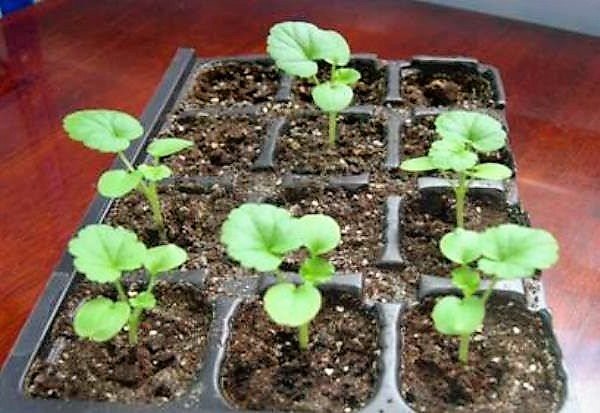

It is believed that seed-grown pelargonium grows more luxuriantly and blooms much better than seed-grown pelargonium. May be. But this method is more complicated and time consuming. Buy seeds in special trusted stores. Sowing time is January or February. Spread the seeds on a slightly damp substrate in a container, close the lid. You can use another container, then cover it with foil or glass. Place in a warm, dark place. The temperature should be in the range of 20 - 25 gr. After a week or two, the first shoots should appear. Move the container or other container with seedlings to a bright place. Open the lid of the container slightly to ventilate the greenhouse and remove condensation that has accumulated there. When two true leaves appear on the seedlings, they need to be cut out. It is desirable to reduce the temperature of further content to 16 - 18 gr. After a couple of months, the grown pelargoniums can be planted in small pots and begin to care for them like adult plants.
Dividing the bush
Sometimes an adult plant is propagated by dividing the bush into two approximately equal parts. To do this, remove the plant from the pot. Shake off the soil from the roots. Gently straighten and distribute the root system in two. With a sharp, clean knife, they divide the bush into two parts. Slices must be sprinkled with crushed charcoal or activated carbon. Each part of pelargonium is planted in its own pot according to all the rules for a successful planting. Healthy, robust plants will quickly regain their shape and bloom that summer.
Restoring geranium if leaf tips dry
Recovery occurs gradually: for a start, you need a comprehensive affect the affected root system and at the same time raise the temperature of the air or increase the volume of light and the length of daylight hours. Poured or overfed geraniums are better transplant into fresh soil, getting rid of stagnation. To restore roots use "Zircon" in small doses. After full resuscitation, after 1 month, add potassium and phosphorus - without nitrogen - into the ground to strengthen the processes of roots and shoots. Celebrate the condition of geraniums after restorative procedures.
↓ Write in the comments why did your geranium leaf tips dry?


